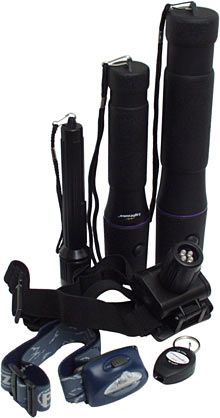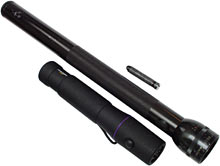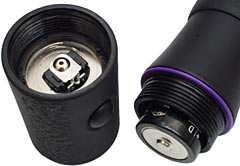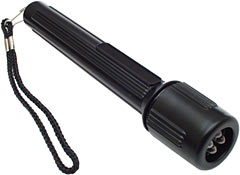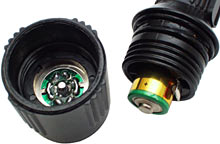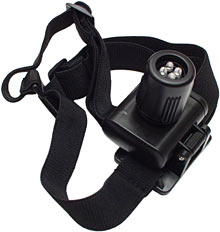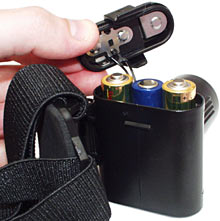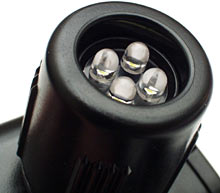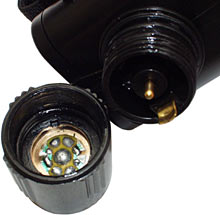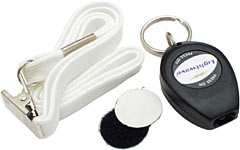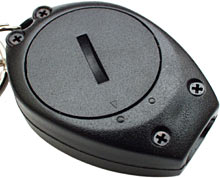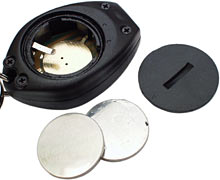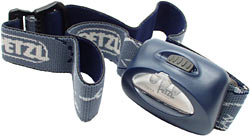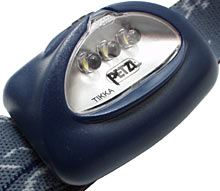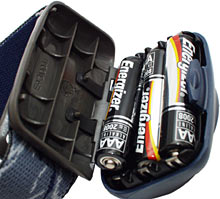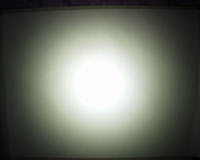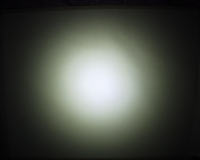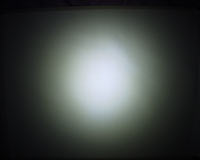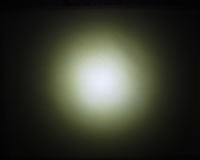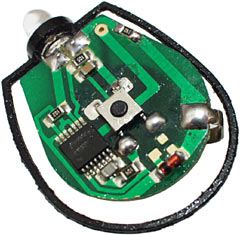
Comparison: Lightwave 2000, 3000, 4000, Illuminator and Pocket-Bright, and Petzl Tikka
Review date: 14 February 2002.Last modified 03-Dec-2011.
There are two good reasons to not bother buying an LED flashlight.
One, they're not tremendously bright.
Ordinary high intensity LEDs have excellent light output by penlight standards, and white LEDs give you a lovely smooth pool of blue-white light instead of the ring-distorted yellowish light that you'll get from incandescent bulbs.
But if you want more brightness than a penlight can deliver, from a flashlight that uses ordinary LEDs as its light source, then you need multiple LEDs.
If you want to get the output of a good-sized battery powered flashlight - a normal security-guard-issue Mag-Lite, for instance - from an LED light, you'll need a ridiculous number of LEDs. And the resultant light can't be focussed, which is an essential feature for a lot of powerful-flashlight applications. Diffuse light is better than tight-beam for general near-field lighting, but close to no LED lights give you the choice.
Problem two with LED flashlights is that they're pretty expensive, especially if they use a lot of LEDs. High intensity LEDs can cost a few dollars each.
On the plus side, you'll never need to buy another bulb, since any LED flashlight that doesn't seriously overdrive its LEDs should give you several tens of thousands of hours of lamp life, and possibly a great deal more.
And you'll save money on batteries, too. White LEDs are only about as efficient at turning electricity into photons as a halogen incandescent lamp; they're better than cheaper incandescents, but not by a huge margin. But white LEDs stay white even when their batteries are very nearly flat; incandescent globes slide off into dark orange uselessness as their input voltage falls.
LED lights that use coloured LEDs, blue or green ones for instance, are more efficient than halogen globes.
So there's that. But the purchase price can still sting a bit.
Which means it's nice to find some decent LED flashlights that don't cost more than other quality torches.
Never mind rattly supermarket flashlights. They're likely to be fine for household use, but if you want something you can drop off the roof and still use afterwards, then you've got to pay for it.
Shop around and you can find a three-D-cell Mag-Lite - the usual model for people who want solid light output, a certain amount of improvised-truncheon value, and high durability - for less than $US30. Less than $US25 from the really cheap places. More than $US40, if your shopping-fu is not the best.
This is a lot less than you'll pay for practically any high brightness LED flashlight. Tektite's LED flashlights, some of which I review here, are generally excellent. But a little baby one will cost you as much as a 3-D Mag-Lite, and you can pay well over $US100 for the fancier models. You'll have to, if you want output power comparable with the Mag-Lite.
Accordingly, I was pleased to see the street prices for Lightwave's LED flashlight range, when they sent me some lights for review. The most you'll pay for a Lightwave is about $US59. And that buys you a pretty impressive light.
The Lightwave 4000
LED flashlights generally lack a certain... chunkiness.
Various LED lights are very solidly made, and there's the odd metal-cased model like the aluminium LEDCorp light I review here, but there's really not much out there with solid burglar-bopping potential.
On a less aggressive note, it's also hard to find an LED light that runs from D cells. That's because most LED lights have low enough power consumption that AA or C batteries are more than adequate for impressive run times. But Ds are the way to go if you want a light that'll really keep on trucking for a very long time.
Use D cells to power a flashlight and it's going to be bigger and heavier, of course. Which brings us back to the flashlight-as-club issue.
To fill this niche, there's the Lightwave 4000. It's a three-D-cell flashlight with a 10 LED lamp, it's got a plastic body with rubber armour on each end and over the grip area, it's got an O-ring seal for more perfectly adequate waterproofing as long as you don't intend to take it diving, and it's got a rubber-sealed pushbutton switch. And a wrist strap. For $US59.
It's not quite as much of a bargain as you might think, because it doesn't come with batteries. But it's still pretty cheap for what you get.
The 4000's about 265mm long (10.5 inches). Here it is compared with two ends of the flashlight size scale - my six-D-cell Mag-Lite +20 Flashlight of Bashing, and the single-AAA-cell Arc-AAA that I review here. The little Arc is a pocket flashlight; it's smaller than a Mag-Lite Solitaire. The other two... aren't.
Like the other flashlights in the Lightwave range, the 4000 has no separate tailcap; you get at the battery compartment by unscrewing the lamp assembly. Lightwave tell me that the back of the LED array is mummified in silicone potting compound, which renders it thoroughly waterproof and also helps cool the LEDs a bit. Well, it helps more than air would, anyway.
Because this isn't a twist-the-end switch design, the contacts should last for ages. The light comes from the factory with a thin layer of protective grease on the threads and contact area, which ought to keep it pretty safe even if you manage to let water into it.
In use, the Lightwave 4000 feels solid and serious, but it's not as bright as you might expect, for its size. Some flashlights that are, mind you, get that way by overdriving their LEDs; the 4000 doesn't do that, as we'll see in the Power Consumption section below. And it's still definitely a lot brighter than most LED lights.
If you're expecting searchlight brightness, though, you're not going to get it. The big batteries are there for long run time, not astounding output.
You can, by the way, use a variety of Nite Ize flashlight accessories with the Lightwave lights, if you need a belt-hanger or holster or such. Lightwave list the appropriate widgets on their product page.
The Lightwave 3000
The 4000's little brother, the 3000 has seven LEDs and runs from three C cells (not included, again). It's got all of the basic features of the bigger LightWave, but it's about 220mm (8.75 inches) in length, and costs $US49 or thereabouts.
The 3000's lamp arrangement is, of course, very much the same as that of the 4000. It feels much the same to use, as well.
Surprisingly, the 3000 turned out to be about as bright as the 4000, if not brighter, despite having three fewer LEDs. That means the 3000 has to be working its LEDs and batteries harder, of course; more on that in a moment.
The Lightwave 2000
This is LightWave's version of the ISO Standard Small LED Flashlight - three AA cells (included, this time!), four LEDs, and a twist-the-end switch. It's a neat little unit, about 180mm (7 inches) in length, but its plastic body doesn't have the rubber extras of the bigger Lightwaves. It's only a $US29 product, though; that's not bad for a batteries-included four-LED light.
A twist-switch can be quite hard on the contacts at the base of the lamp assembly; the 2000's lamp is, accordingly, solidly constructed, with a thick contact trace around the edge.
A twist-switch is also a standard feature of a lot of dive lights. Pushbutton switches don't work at much of a depth, because the pressure pushes them for you. But the Lightwave 2000 isn't a dive light; it's waterproof, but only to two feet.
The 2000's available with red, blue and green LEDs as well as white; the other Lightwaves are white-only.
In use, this light's a perfectly good, solid, workmanlike product. More than bright enough for indoor flashlight duties (one LED's enough for that); not a night-slicing monster outdoors, but up there with every other four-LED light I've seen.
I've used rather nicer four-LED lights than this one; my favourite "flashlight-shaped" one so far would have to be the Traser Teknolite, reviewed here, and Technology Associates' bar-of-soap-shaped Ergo EternaLights (originally reviewed here) have a place in my heart, too. But the basic Ergo EternaLight is $US40, and the Teknolite costs even more. For the money, the 2000's more than adequate.
The Lightwave Illuminator
Lightwave's $US40-ish Illuminator headlamp looks vaguely like one of those protruding-lens helmet-mounted night vision scopes, because it uses basically the same lamp assembly as the 2000. The lamp's now attached to a rectangular battery case, though, with a quality adjustable two-strap headband (one strap around the head, one over the top) to hold it on your noggin.
The Illuminator battery compartment has a double-sided clip arrangement that's not terribly hard to remove, but shouldn't pop free because of misadventure. It's got another rubber seal, too; once again, this light is waterproof, but not to any depth beyond what you'd find in your bathtub.
Batteries are, once again, not included.
All of the Lightwave lights have a thick rim around their LED array, which is good for two reasons.
One, it protects the LEDs; they're not breakable, but if you drop a flashlight LEDs-down onto a hard floor then you still want something other than LEDs to take the shock.
Two, the lip stops light from spilling out sideways, where it'll dazzle you annoyingly. If you want a flashlight that works as a beacon then lots of light-spill is handy, but most of the time you just want light where you're pointing the thing, thank you. The Traser Teknolite, with its clear end-piece, is an offender in this regard; the Lightwaves are much better.
The Illuminator and 2000 lamps aren't quite the same - the Illuminator one has a simple button in the middle to meet the spring-loaded contact coming out of the battery box, while the 2000 has more of a prong in the middle to help it contact AA cells.
In case you're interested, though, the two lamps are interchangeable. If you're using under-length AAs in the 2000 (rechargeables, or crashed-and-bashed alkalines) then it might be a bit dodgy with the shorter-contact lamp, but it's not much of a difference.
The Illuminator is comfortable enough to wear; all of the weight's on the front of your head, but the thing doesn't weigh a ton, and the two-strap design is easy to adjust to suit your cranial dimensions, helmet or what have you.
The headlamp's forehead plate is padded and curved, as should be the case with any headlamp not meant to be worn by Kryten. You'd think every headlamp would have a proper forehead plate, of course, but some don't.
The Illuminator has a plastic clicky-hinge sort of arrangement to hold it at the angle you want, from straight-forward to hitting-your-nose. This is the only feature of the light that I think could do with serious improvement; the detents in the hinge aren't positive enough, and it can flop around a bit unless you tighten the hinge screw, which makes the angle harder to adjust.
That hinge isn't going to start working any better as it wears, so this might not be the light to choose for strenuous activity where you don't expect to have a hand free to deal with a headlamp that's just decided it's time to illuminate your crotch. This isn't a major niggle, though; most people aren't tweaking their headlamp angle every ten seconds, so just cranking down the hinge screw is an OK workaround.
The Lightwave Pocket-Bright
Lightwave's entry in the key-ring light market is this chunky little customer.
The Pocket-Bright is small, by most people's standards, but it's big compared with a lot of its competition. It's about 45mm long (1.8 inches) not counting the key-ring, and 30mm wide (1.2 inches), which isn't all that unusual. But it's 14mm thick (0.55 inches), which is a bit on the fat side.
Not that many people are likely to care, mind you. You could still fit two Pocket-Brights in the Zippo pocket of a pair of jeans, with some room to spare.
As well as the de rigeur key-ring, the Pocket-Bright comes with a neat spring-clip lanyard/neck strap thing, and a couple of self-adhesive hook-and-loop dots so you can stick the light to something.
The Pocket-Bright doesn't have a mere electromechanical switch; it's a press-on, press-off light. You push on the middle of the sticker on the top to switch it, and you don't have to fiddle with little plastic slide-switches, or simpler "squeeze lights" that're only on while you're squeezing them.
You need a reasonable amount of pressure to activate the Pocket-Bright switch, so it's not too likely to go off in your pocket. If your pocket also contains two pocket knives, 23 keys, two access cards, a walkie-talkie and a small Wankel engine, though, all bets are off.
The Pocket-Bright probably was, as Lightwave say, "the only light with an IC chip and printed circuit board to digitally control the light" when it first came out, but it isn't now; the Photon Micro-Light 3 has press-on, press-off operation too, and adds a bunch of dimmer and flasher modes as well. I review the Photon 3 here, by the way.
The dimmer modes in the Photon 3 are one of its best features, because the problem that all key-ring flashlights have is that they invariably over-stress their tiny little batteries.
The only way to make a light as small as this is by using lithium "coin cells" as your power source. These tiny cells are meant to be used for memory backup in electronic devices, for powering wristwatches, and for other such low-drain duties; their capacity ratings rely on a drain of only a tenth of a milliamp.
A single high intensity LED, on the other hand, will suck tens of milliamps out of these poor little cells. Which is why two three-volt cells have to be stacked in order to power a single blue or white LED; their six volt unloaded output gets sucked down to the 3.6 to four volts that the LED wants by the heaviness of the load.
The Pocket-Bright does its best to reduce this problem, in two ways.
First, it uses beefier coin cells than normal. Its battery door is a simple twist-lock design that you open with a coin...
...and with a bit of persuasion from a small pointy thing too, at least in the case of the Pocket-Bright I got for review. It loosened up after a couple of openings.
Instead of the usual CR2016 cells (20mm diameter, 1.6mm thickness), the Pocket-Bright comes with two CR2025 coin cells, pre-installed. 2025s have almost twice the rated capacity of 2016s; their capacity's likely to be about 110mAh, versus 60mAh for a 2016. They're also likely to have slightly better performance under high load, which means Lightwave's claim that their batteries have twice the capacity of CR2016s is fair enough.
CR2025s will still be emitting thin reedy shrieks when loaded with one bright LED, of course. But they will last better, all things being equal.
To further improve the Pocket-Bright's overall performance, Lightwave say its circuitry deliberately avoids overdriving the LED from new batteries. The usual way of reducing LED current to spare batteries or, more commonly, the LED itself, is by simply putting a current limiting resistor in series with the LED; Lightwave say their "printed circuit board + IC chip" is responsible. More on that later.
On the above-linked "Pocket-Bright Advantages" page, Lightwave go on about the various ways in which the Pocket-Bright beats a Photon Micro-Light, which is the original Photon "squeeze light". They're rolling together the features of the Photon I and II, though, and not mentioning the 3 at all.
Changing the batteries in a Photon Micro-Light II, not I, can indeed take a while, because the case is held together by four small screws. Without the right screwdriver, you're not going to do it at all.
The Photon I and Photon 3, on the other hand, have a pop-open case that makes battery swaps only slightly more fiddly than they are with the Pocket-Bright.
The ASP Sapphire Light that Lightwave also have in their comparison table, by the way, has a battery change time of about a month. That's because you're expected to send it back to the manufacturer, along with three US dollars, when the batteries go flat. It's possible to crack the case and replace the batteries yourself, but it's not at all easy. But you can buy Sapphire Lights with US delivery included for $US15.99 from places like this, so whaddayawant.
The Pocket-Bright battery door has a rubber-ring seal inside, and there's another rubber gasket between the two halves of the case, which makes the light waterproof. Only to one foot, but that's still more than Photon can claim. The Photon I is "water resistant", and you needn't be too worried about using any Photon in the rain, but it's not a great idea to drop a Photon II or 3 in a puddle.
Photon 3s cost $US25.95 including US shipping, from the manufacturer; you can buy the Pocket-Bright from, wait for it, pocket-bright.com for $US19.95, ex shipping. So there's nothing in it, price-wise.
The Petzl Tikka
Up against all of the Lightwaves in this comparison is this baby headlamp, made by Petzl. Petzl make a large amount of gear for exciting adventures in the great outdoors, and also for rescuing people who find themselves having a more exciting adventure than they expected.
The Tikka headlamp has three LEDs, uses three (included) AAA cells to power them, and is lashed to your skull with a simple one-piece round-the-head elastic strap. It weighs a mere 70 grams (2.4 ounces) including batteries. And it's only $US35 or so.
The Tikka lamp is simple and elegant. Around the LEDs there's a shiny-frosted reflector area; since almost all of the light output from normal LEDs comes out of the front of the lens, this doesn't do a great deal. But it doesn't hurt.
The plastic LED-protector on the front is removable; it removed itself when I dropped the Tikka onto a concrete floor, but it snapped back in easily and no other damage was done, beyond a scuff mark on the case. You can get coloured lenses to replace the standard one; this is an OK quick and dirty way to get yourself a coloured headlamp for night-vision-preservation, concealment from your midnight-paintball opponents or, heck, darkroom use.
There's a (somewhat stiff) slide-switch on the top of the Tikka lamp assembly, and that's about it for its functional features; this headlamp has no hinge. If you put the lamp on the middle of your forehead, it shines downward pretty much where you want it to for normal seeing-where-you're-going purposes. If you want it to shine straight ahead, you can just push it up your forehead a bit. Hey, don't knock it, it works. Adjust the band tension properly and this light should stay where it's put every bit as well as any hinged light would.
You open the Tikka battery bay by prodding the latch at the back with... well, with whatever comes to hand, really. The instructions show a the buckle from the headband being used; a coin works, too.
There's no waterproofing gasket here; the Tikka should be fine in all but the most torrential rain, but it'd be a good idea to take it off before the school bully flushes your head.
The back of the Tikka lamp is a simple curved buckle arrangement with no more padding than is offered by the elastic strap. That's not a problem, though; this thing's so light that it's very comfortable to wear, even without much padding. You can only just tell that there's actually a light there at all.
The Tikka's brightness is quite impressive, considering that it's all coming out of only three LEDs. That, of course, means that the little AAAs must be pretty heavily loaded, and the LEDs must be pushing pretty hard, at least until the batteries start going flat.
Petzl claim the Tikka will be good for five to ten metre visibility for the first 12 hours of battery life, better than two metres for the next 12 hours, and won't dribble away to nothing until about the 150 hour mark. We'll see about that in a moment.
Petzl also, by the way, make the "Zipka", which is exactly the same as the Tikka but has a retractable cord instead of the elastic version. So it's even smaller to carry, and can be attached to your wrist or ankle or... well, anywhere, really.
Don't send me pictures. I'm serious.
Light output
For the output tests, I used my usual setup - a sheet of A3 paper, long edge horizontal, 40cm in front of my f2.8, ISO 100 digital camera. A 1/20th second shot at this setting will, as a general rule of thumb, be overexposed if a light's worthwhile for seeing something on the other side of the yard at night; a 1/5th second exposure will give a solid result from anything that's bright enough for indoor use. And if your eyes are acclimatised to darkness, you can make do with considerably less light.
I set the white balance with the output from another LED flashlight, so the overall tone of all of these pictures is white, instead of the somewhat blue-white that they all really are. The blueness of the output from almost all LED flashlights, though, is much less pronounced than the yellowness of the output from household incandescent lights.
A 1/20th second exposure of the Lightwave 4000's output is quite overexposed...
...and this 1/40th second snap is on the way to overexposure, too. That's good.
Note the slight green tinge; the LEDs in my review 4000 tended more towards that hue than is usual. The light doesn't look at all green unless you compare its output with other LED lights, though; it's a subtle tint.
The Lightwave 4000 isn't the brightest LED flashlight I've ever seen, but it's not far off the mark. It's far dimmer than the much more expensive incandescent flashlights used by people who want a belt-carried spotlight, and it can't zoom, either, so it's not a lot of use for looking at things more than about 10 metres away.
If you're looking for a good solid wide-beam flashlight for use in even quite large indoor areas, though, the 4000 fits the bill. If you're a law enforcement type (or just someone who for some other reason owns a lot of products with the word "tactical" in their names), you can always hang an excruciatingly bright mini Surefire light on your belt for long-range use (the Surefire "120 lumen" lamp assembly for their 4.9 inch 6P light is good for something like eight watts), and use the less offensive Lightwave for more pedestrian tasks. And for when you want more than 20 minutes of battery life.
Here's a 1/40th second shot of the output from the Lightwave 3000. It's hard to pick a difference between it and the 4000 in the pictures, but in person the 3000 actually seems a hair brighter. The whiter LEDs in this light don't hurt, either.
The Lightwave 2000 only needs a 1/20th second exposure, but it gives a perfectly adequate result for a four-LED light. It's still brighter than you need for most indoor purposes.
Here's the Illuminator's output, again at 1/20th. Brightness much the same as the 2000, as you'd expect, but it's rather greener. Again, this is a difference that you don't notice if you're not switching lights back and forth.
At 1/20th second, the Pocket-Bright gives a less exciting result than I've seen from other single-LED lights, but that's a feature, not a bug. Key-ring lights that're super-bright from new batteries will have lousier battery life than ones that keep the load down a bit.
At 1/5th, the Pocket-Bright looks about as bright as the 4-LED lights at 1/20th, as you'd expect.
Here's the output from the Petzl Tikka at 1/20th second. Only three LEDs, powered by AAAs instead of AAs, but brighter than the four-LED Lightwave 2000.
This leads one inexorably to the conclusion that the Tikka's not going to stay that bright for too long. Apropos of which, it's time to measure...
Power consumption
Lightwave quote a "900 hour plus" battery life for the 4000; the 3000 scores "700+", and the 2000 and Illuminator get "300+". The Pocket Bright gets "50+".
All of these numbers assume you're happy to use your flashlight even when it's outputting a lot less light than it did from fresh batteries. Lightwave define end-of-useful-life as the point where you can't use the flashlight to read newsprint, if you're holding said flashlight six inches away from the newspaper.
Whether you're going to keep your old batteries that long or not is a matter for debate, but LED lights do last longer on a set of batteries than incandescent ones with similar output. The constant output colour of LEDs as their power level drops means that batteries that'd be good for nothing in practically any other device will still give you better-than-nothing light in an LED flashlight.
That said, though, some people think that LED flashlights actually have monstrous battery life and impressive brightness for the whole of that life, and that isn't true.
Hooking up the multimeters to the Lightwave 4000 revealed that it knocked three almost-new D cells down from 4.8 volts to 4.5 when it was turned on, which isn't a horrible voltage loss.
The more current you ask for from alkaline or dry cells, the more their output voltage will sag. Rechargeable cells (nickel cadmium and nickel metal hydride) have much lower internal resistance than non-rechargeables and hardly sag at all under normal battery-powered-appliance loads, but their nominal per-cell voltage is only 1.2 volts, against 1.5 volts for non-rechargeables. So most flashlights will be brighter from alkalines than from rechargeables; only really high power units work better from NiCd or NiMH.
The Lightwave 4000 drew about 290 milliamps (mA) from its batteries. That's through my ammeter, which adds a bit of resistance of its own and so reduces the current. I didn't measure the voltage from the batteries and then fake the same voltage across the lamp using a bench supply, owing to a sudden attack of pernicious laziness. Less-than-new batteries would deliver less power, anyway.
To cut a long story short, you're probably talking about 1.3 watts for this thing. That's less power than you'll get from a three cell Mag-Lite; how much power one of those sucks depends on the bulb you install, but it ought to be more than two watts for the stock bulb and fresh batteries.
The cleaner white output of the LED light, though, means that for close-to-medium-range purposes - seeing where you're going, seeing things you could spit on - the Lightwave 4000 will beat a three cell Mag-Lite, and probably even beat a six cell one. If you need to see stuff a long way away, the Lightwave's close to useless, because you can't focus its beam.
As regards the Lightwave "900 hour plus" run time for this light - well, given 12 to 15 amp-hour (Ah) capacity for D cells that aren't too heavily loaded, and given the fact that this flashlight doesn't present a tremendously heavy load even to fresh batteries, and given the low light output that Lightwave define as end-of-life, the claim's not ridiculous.
If the Lightwave 4000 drew 290mA all the time then it'd eat up its batteries in a couple of days at most, but the current draw will fall as the battery voltage falls, and I wouldn't be at all surprised if I could still read a book with this thing after leaving it on for five weeks. It obviously wouldn't be bright, though; 900 hours of life from three D cells means an average power of only around 70 milliwatts, and much less than that at the right-hand end of the graph.
Incidentally, with a peak current per LED of not much more than 30mA, this flashlight should get excellent lamp life. It might even manage the oft-quoted hundred thousand hour run time before the LEDs drop to 80% brightness. So, barring horrible accidents, it ought to work functionally forever.
Interestingly, the seven-LED Lightwave 3000 actually drew more current than the 10-LED 4000. It sucked its batteries down from 4.8 volts to 4.4, and ate about 330mA in the process. Probably more than 1.5 watts, without the ammeter in-line, and a peak of maybe 50mA for each LED. Which is high by normal electronic standards, but not all that alarming compared with many LED flashlights; the LEDs in this light should last OK, too.
The run time estimate for the 3000 seems a bit more optimistic than the estimate for the 4000. More current and smaller batteries means much earlier battery death; C cells only have about half of the capacity of Ds, and only about half of the current capacity, too. After more than 700 hours, it would not astound me if this flashlight had about the same luminous output as my mobile phone backlight. Compared with an incandescent light, of course, it'll still win by miles.
The two four-LED Lightwaves tested, as you'd expect, about the same. Around 130mA at 4.4 volts from nearly-new AAs; probably better than 0.6 watts from new cells with no ammeter in the way. This isn't a criminally high load for AA alkalines, and it's not a threat to the lifespan of the LEDs, either.
AA cells have about a third of the capacity of C cells, though. To manage the "300 hour plus" run time Lightwave claim for the 2000, the average power of the light would have to be about 40 milliwatts, even if you're using spiffy top-class brand name alkalines.
The Pocket-Bright drew, through the ammeter, 40mA from fresh cells. Which, at that rate, won't stay fresh for long.
I was interested to see exactly how the Pocket-Bright's grandly described current limiting system affected its behaviour as its batteries aged, so I gave it the full fake-batteries treatment, and looked at the current draw versus voltage across the battery terminals over a range from a bit above five volts to less than three.
The Pocket-Bright behaved, in this situation, like a white LED with a current limiting resistor in series. From five volts (brand new batteries won't give it much more than that) it drew 33mA, for 165mW output, and the current draw sagged away smoothly to about 0.4mA at 2.8 volts.
Most tiny-lights just connect the LED directly to the batteries, which means it'll get more than 50mA when the batteries are new. That's not too good for the LED, but it won't have to put up with the mistreatment for long, because 50mA-plus will beat coin cells to death in short order.
Well, the Pocket-Bright circuit board does have a chip, as advertised, but it's there to do the switching; I don't think it's doing much in the way of current limiting.
The reason for this opinion on my part is that the component visible at the top of the board in this picture is a surface mount resistor, in series with the LED's positive lead. The resistor has "390" printed on it.
That doesn't mean 390 ohms. Surface mount resistor number codes give you the first two digits of the resistor value in the first two numbers, then a power-of-ten multiplier in the last number. Ten to the power of zero is one, so this is a 39 ohm resistor. That means the LED's running at about 3.7 volts from fresh batteries, which is the sort of number you expect to see to get a bit more than 30mA from an LED specified for 20mA at 3.6V.
I love it when the numbers make sense.
With its sensible peak draw, the Pocket-Bright doesn't have the stunning new-batteries output of other white LED tiny-lights, but it's a more sensible proposition over time; the fatter coin cells it uses have to help, too.
A white Photon 3 will draw maybe 60mA from two fresh CR2016s, which is very bad for them. But in its medium and low brightness dim modes, it draws only 15.5 and 4.5mA, respectively. If you use those modes judiciously, you should be able to get much better battery life from a Photon 3 than from any other tiny-light, including the Pocket-Bright.
Nonetheless, Lightwave's "50 hour plus" rating for the Pocket-Bright sounds pretty reasonable to me. At the end of 50 hours of operation the Pocket-Bright will be far, far dimmer than it was at the beginning, but you'll still be able to find your way to the bathroom at night using it.
Or, less prosaically, see to change the batteries in your bigger light. Lots of people use key-ring lights as practically weightless emergency backup lights to supplement some chunkier photon-spitter. The Pocket-Bright looks like a perfectly good candidate for this role, as well as for domestic tiny-flashlight duty.
Back in the land of proper batteries - well, AAAs, anyway - the Petzl Tikka knocked 4.7 volts worth of fresh AAAs down to 4.3V, drawing 180mA in the process. About a third again as much power draw as the four-LED Lightwaves, which explains the higher brightness. 60mA-plus per LED, too, which is a tad steep, but won't last. AAAs have about half of the capacity of AAs, and much lower current delivery capability as well, so I think Petzl's brightness curve is a bit on the optimistic side. 12 hours of night-hiking usefulness from one set of batteries is still perfectly plausible, though. And, once again, you can really wring your batteries out to the very last electron, if you want.
Overall
The MUST BLIND PEOPLE TODAY! demographic still aren't interested in LED lights. New LED designs like the Lumileds Luxeon products may change that. "Luxeon Star" LEDs have the output of 10 to 20 normal LEDs, and are starting to show up in real products - like, for instance, Arc Flashlight's new Arc-LS, one of which I'll be getting for review just as soon as Arc stop pre-selling every one of the things they can make. I wouldn't be amazed if single-element, zoomable LED flashlights with five or ten watt output powers existed in a few years.
Right now, though, you still need incandescent if you need a really powerful, zoomable beam. And Lightwave haven't made anything that'll cause the world of portable lighting to be turned upside down. But they have made well-priced, solidly constructed LED flashlights that get the job done and should continue to do so for a long, long time; LED array flashlights may look old fashioned in the year 2012, but they'll still be working fine, and they're as bright as you need for many purposes.
Petzl's Tikka's great, too. Once again, if you need a super-grunty headlight, this isn't one. But it's plenty bright enough for most purposes, it's so light you can hardly feel it, and it's not stupidly expensive. I like it a lot. It's not as good as the FrontaLED Trekker I reviewed a while ago, but you can get almost four Tikkas for the price of a Trekker, so that's hardly surprising. The Lightwave Illuminator's a perfectly good headlamp and only costs a little more than the Tikka - but it's just not as stylish. Sorry.
People who like it when I bash lousy products will be disappointed by this review, because I like all of these lights.
I suggest you go and buy one.
